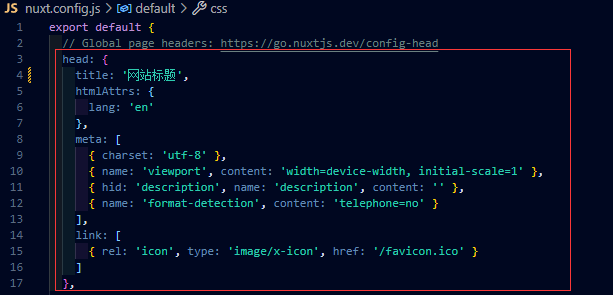- A+
- 1.1如何进行搜索引擎优化?
- 1.2-预渲染
- 1.3-服务端渲染(通过SSR)
- 1.4-优势劣势总结
- 2.1-安装与创建
- 2.2-目录结构(VueCli 与 Nuxt 对比)
- 2.2-服务端生命周期
- 2.2-服务端与客户端共有的生命周期
- 2.3-客户端生命周期
- 2.4-Nuxt路由
- 2.5-Nuxt导航守卫
- 3.1-Head
- 3.2-CSS
- 3.3-Model与数据交互
- 3.4-配置代理
- 5.1-路由配置
- 5.2-代理和扩展$axios解耦
- 5.3-引入VueX和组件重构
- 5.4-引入ElementUI(按需引入)
- 6.1-项目打包
- 6.2-Nuxt发布IIS绑定域名
- 7.2-nuxt中使用svg-icon
- 7.3-nuxt中使用cookie
- 7.4-nuxt中使用代码高亮highlight.js插件
- 7.5-nuxt中使用全局水印
- 7.6-nuxt中实现图片放大预览功能
- 7.7-nuxt中使用windiCSS
官网:https://www.nuxtjs.cn/
搭建Nuxt2-参考文献:https://blog.csdn.net/weixin_44198965/article/details/125408111
一、为什么用Nuxt
SEO:所搜引擎优化
1.1如何进行搜索引擎优化?
- 多页面
- Title、描述、关键字
- 网站内容
1.2-预渲染
1.2.1-预渲染图解
1.2.2-如何使用?
(1)vue项目中按照prerender-spa-plugin
npm install prerender-spa-plugin -S
(2)vue.config.js进行配置
修改Title、描述、关键词:vue-mate-info
(1)下载
npm install vue-meta-info -S
(2)到页面组件中进行配置
metaInfo:{
title:"西瓜程序猿",
meta:[{
name:"关键词,西瓜程序猿",
content:"描述"
}]
}
1.2.3-预渲染总结
可以解决:
1.打包多页面
2.可以解决每个页面单独生成title、描述、关键词
3.解决数据是在html生成放在页面上的,爬虫可以抓取到内容。存在的问题:
1.预渲染无法配置动态路由
2.如果title、描述、关键词来与接口的数据,配置到met-info也是不行的。适合做什么项目:
1.一个项目可以某几个页面要做SEO
1.3-服务端渲染(通过SSR)
1.3.1-预渲染图解
1.3.2-服务端渲染总结
适合做什么项目:
1.一个项目可能所有页面要做SEO(博客、内容网站)
1.4-优势劣势总结
1.前后端不分离
压力在后端
好处:安全2.前后端分离
2.1-SPA单页面应用[vue-cli本身处理不了SEO]
压力在客户端2.2预渲染
压力在客户端
问题:
1.在heml页面加载之前数据过来渲染后才有html的DOM结构,这样的话可能会存在一定时间空白页面的情况。
2.一个项目不是所有页面都做SEO。2.3-服务器渲染
压力在客户端
问题:启2个服务[一个是后端自己的语言服务(C#/Java),一个是Node.JS的服务]
二、Nuxt安装与使用
2.1-安装与创建
2.1.1- 确保安装了 npx(npx 在 NPM 版本 5.2.0 默认安装了):
npm -v
npx -v
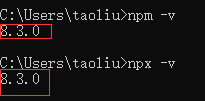
2.1.2. 创建一个Nuxt项目
(1)输入命名进行创建。
npx create-nuxt-app <项目名>
(2)选择项:
Project name——项目名称
Programming language——程序设计语言
Package manager——包管理器
UI framework——UI框架
Nuxt.js modules——NuxtJS模块(如果需要安装某个需要按"空格"电亮才行)
Linting tools——代码校验工具
Testing framework——测试框架
Universal——渲染模式(SSR:服务端渲染、SSG:静态页面生成)
Deployment target——部署目标
Development tools——开发工具
What is your GitHub username?——GitHub名称
Version control system——版本控制工具
演示如下:
创建成功如下如: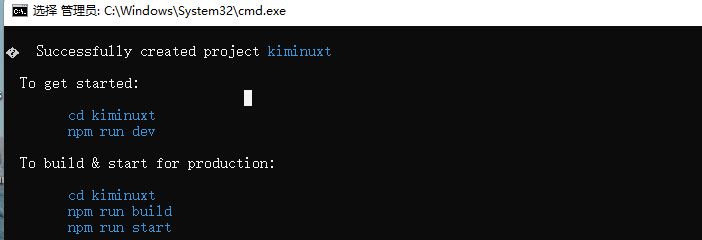
2.2-目录结构(VueCli 与 Nuxt 对比)
pages——页面(类似于:src/views)
components——组件(类似于:src/components)
static——静态资源(类似于:scr/assets)
store——vuex状态树(类似于:src/store)
muxt.config.js——全局配置文件(类似于:vue.config.js)
如下: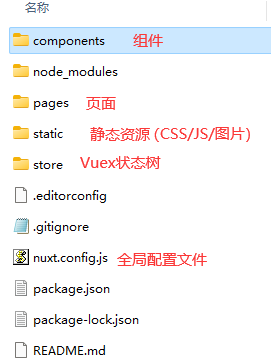
2.2-服务端生命周期
2.1.1-nuxtServerInit(store,context){}
参数1:vuex上下文
参数2:nuxt上下文
2.1.2-middleware()
全局:
全局导航守卫export default function(){ console.log("middleware kimi")}局部:
第一种页面级别导航守卫 middleware:"kimi",
第二种页面级别导航守卫 // middleware()
2.1.3-validate({params,query}){}
判断URL参数是否符合标准,页面中写。
validate({params,query}){
校验参数
...
console.log("3.validate...")
returntrue;
}
2.1.4-asyncData()——限于页面组件
会在这个里面做发送请求的操作。
2.1.5-fetch
fetch 方法用于在渲染页面前填充应用的状态树(store)数据, 与 asyncData 方法类似,不同的是它不会设置组件的数据。
2.2-服务端与客户端共有的生命周期
beforeCreate(){
console.log("6.beforeCreate")
},
created(){
console.log("7.created...")
},
2.3-客户端生命周期
beforeMount(){
console.log("8.客户端beforeMount...")
},
mounted(){
console.log("9.客户端monted...")
},
beforeUpdate(){
console.log("10.beforeUpdate...");
},
updated(){
console.log("11.updated...");
},
beforeDestroy(){
console.log("12.beforeDestroy...");
},
destroyed(){
console.log("13.destroyed...");
}
2.4-Nuxt路由
2.4.1-路由跳转的三种方式
Link的方式 <button @click="toList">js跳转
toList(){
this.$router.push({
path:'/list',
query:{
id:123
},
params:{
id:321
}
});
}
2.4.2-使用已有的VueCli路由文件
(1)安装插件。
npm install @nuxtjs/router -S
(2)在【nuxt.config.js】文件的【modules】模块中配置。
modules: [
'@nuxtjs/router'
],
(3)在根路径删新建一个【router.js】文件,文件名必须为router。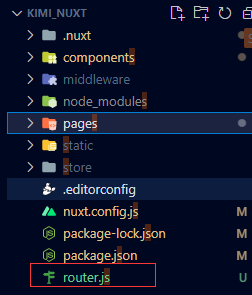
(4)修改该文件的内容。
importVuefrom"vue" importVueRouterfrom"vue-router" importHomefrom"@/pages/haverouter/Home.vue" importAboutfrom"@/pages/haverouter/About.vue" importNewsfrom"@/pages/haverouter/News.vue" Vue.use(VueRouter) const routes=[ { path:'/home', name:"Home", component:Home }, { path:'/about', name:"About", component:About }, { path:'/news', name:"News", component:News } ] letrouter=newVueRouter({ mode:"history", routes }); //全局导航守卫 router.beforeEach((to,from,next)=>{ if(to.name=="About"){ next("/news") }else{ next() } }) exportfunctioncreateRouter(){ returnrouter; } 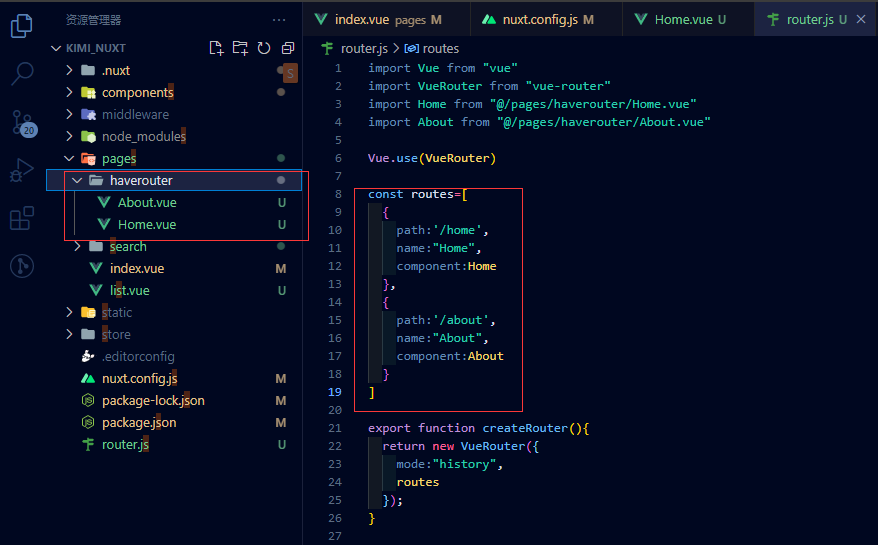
2.5-Nuxt导航守卫
2.5.1-router.js
vue-cli中怎么用,next中就怎么用,几乎一样。
//全局导航守卫 router.beforeEach((to,from,next)=>{ if(to.name=="About"){ next("/news") }else{ next() } }) 2.5.2-NuxtJS
中间件:middleware
全局: // 全局导航守卫 export default function(store,route,redirect,parms,query,req,res){ console.log("middleware kimi") } 局部: //第一种页面级别导航守卫 middleware:"kimi", //第二种页面级别导航守卫 middleware(){ console.log("我是全局导航守卫") } 插件:plugins
(1)在【nuxt.config.js】的plugins进行配置。
plugins: [
'~/plugins/router.js'
],
(2)新建一个【router.js】文件,然后进行配置。
exportdefault ({app})=>{
全局
app.router.beforeEach((to,from,next)=>{
console.log(to)
next();
})
}
2.5.3-使用本地存储
服务端不能使用localStorage和Cookie
需要使用以下模块:
(1)安装
npm install cookie-universal-nuxt -s
(2)在【nuxt.config.js】的【modules】引入
modules: [ 'cookie-universal-nuxt' ],
(3)如何使用
设置cookie:this.$cookies.set('token', 123456) 1
获取cookie:this.$cookies.get("token") 1
清除cookie:this.$cookies.remove('token')
三、Nuxt配置项
3.1-Head
全局在【nuxt.config.js】的[head]中定义。
局部在每个页面中定义,全局已有的可以不用在局部定义。
3.2-CSS
3.2.1-使用全局css
3.2.2-使用ElementUI
(1)下载。
npm i element-ui -S
(2)在根目录新建一个【plugins】文件夹中新建一个【element.js】文件。
importVuefrom"vue"
importElementUI from"element-ui"
Vue.use(ElementUI);
(3)在【nuxt.config.js】文件中进行配置。
css: [ "element-ui/lib/theme-chalk/index.css" ], plugins: [ '~/plugins/element.js' ], 3.3-Model与数据交互
3.3.1-安装axios
方法一:
(1)安装:npm install @nuxtjs/axios -S
(2)在【nuxt.config.js】中配置:'@nuxtjs/axios'
方法二:
(1)安装:npm install axios -S
3.3.2-asyncData生命周期(方法)
pages目录中的页面组件才可以使用,components内的.vue文件不可以使用的。
asyncData中没有this。
3.3.3-fetch生命周期(方法)
fetch是有this的。
3.4-配置代理
(1)安装
npm install @nuxtjs/axios @nuxtjs/proxy -S
(2)在【nuxt.config.js】文件中配置。
modules: [ '@nuxtjs/axios', '@nuxtjs/proxy' ], axios:{ //是否可以跨域 proxy:true }, proxy:{ '/api':{ target:"http://testapi.xuexiluxian.cn/", pathRewrite:{ '^/api':'' } } }, 四、Nuxt使用Vuex状态树
export const state = () => ({ counter: 0 }) export const mutations = { increment(state) { state.counter++ } } 五、项目重构(V-Cli项目重构到Nuxt中)
5.1-路由配置
(1)安装
npm install @nuxt/router -S
(2)在【nuxt.config.js】文件中进行配置。
modules: [ "@nuxtjs/router" ], (3)把vue-cli中router文件拷贝到nuxt项目根目录中,并命名为【router.js】。
(4)然后修改这个文件。
import Vue from 'vue'; import Router from 'vue-router'; import Home from '@/pages/blog/home.vue';//博客首页 Vue.use(Router); const routes = [ { path: '/',component: Home}, ]; export function createRouter(){ return new Router({ mode: "history", routes, }); } 5.2-代理和扩展$axios解耦
(1)安装代理与axios。
npm install @nuxtjs/axios @nuxtjs/proxy -S
(2)在【nuxt.config.js】文件中进行配置。
modules: [ "@nuxtjs/axios", "@nuxtjs/proxy" ], (3)配置代理。
//开启代理 axios:{ proxy:true, }, proxy:{ "/api":{ target:"http://xx.xx.xx.xxx:8081" } }, (4)创建一个【plugins】文件夹,并新建一个名为【axios.js】文件,配置如下:
export default ( {$axios} ) =>{ //请求拦截器 $axios.onRequest((config)=>{ console.log("请求拦截器..."); return config; }); //异常拦截器 $axios.onRequest((error)=>{ console.log("异常拦截器..."); }); //响应拦截器 $axios.onResponse((response)=>{ console.log("响应拦截器..."); return response.data; }); } (5)在【nuxt.config.js】文件中进行配置。
plugins: [ "~/plugins/axios" ], 5.3-引入VueX和组件重构
(1)创建一个【store】文件夹并在里面新建一个【index.js】文件,内容如下。
import Vue from 'vue' import Vuex from 'vuex' //使用Vuex Vue.use(Vuex) import app from './modules/app' const store = () => new Vuex.Store({ //导入模块 modules:{ app, } }); //导出 export default store; (2)创建一个【models】文件夹并在里面新建一个【user.js】文件,内容如下。
//【应用程序模块】 export default{ //单一状态树,UI可通过this.$store.state.user.*获得数据 state:{ }, // 唯一拥有更改内存数据的接口,不可进行异步操作 mutations:{ }, // 与mutation通讯,UI层写入内存数据的接口,可异步操作 actions:{ } } 5.4-引入ElementUI(按需引入)
(1)安装
npm i element-ui -S
npm i -D babel-plugin-component
(2)新建一个【elementui-ui.js】放在【plugins】文件夹下。
import Vue from 'vue'; // 按需引入ElementUI import { Pagination, Dialog, Autocomplete, Dropdown, DropdownMenu, DropdownItem, Menu, Submenu, MenuItem, MenuItemGroup, Input, InputNumber, Radio, RadioGroup, RadioButton, Checkbox, CheckboxButton, CheckboxGroup, Switch, Select, Option, OptionGroup, Button, ButtonGroup, Table, TableColumn, DatePicker, TimeSelect, TimePicker, Popover, Tooltip, Breadcrumb, BreadcrumbItem, Form, FormItem, Tabs, TabPane, Tag, Tree, Alert, Slider, Icon, Row, Col, Upload, Progress, Spinner, Badge, Card, Rate, Steps, Step, Carousel, CarouselItem, Collapse, CollapseItem, Cascader, ColorPicker, Transfer, Container, Header, Aside, Main, Footer, Timeline, TimelineItem, Link, Divider, Image, Calendar, Backtop, PageHeader, CascaderPanel, Loading, MessageBox, Message, Notification, Avatar, Scrollbar, Empty, Skeleton, SkeletonItem } from 'element-ui'; Vue.use(Pagination); Vue.use(Dialog); Vue.use(Autocomplete); Vue.use(Dropdown); Vue.use(DropdownMenu); Vue.use(DropdownItem); Vue.use(Menu); Vue.use(Submenu); Vue.use(MenuItem); Vue.use(MenuItemGroup); Vue.use(Input); Vue.use(InputNumber); Vue.use(Radio); Vue.use(RadioGroup); Vue.use(RadioButton); Vue.use(Checkbox); Vue.use(CheckboxButton); Vue.use(CheckboxGroup); Vue.use(Switch); Vue.use(Select); Vue.use(Option); Vue.use(OptionGroup); Vue.use(Button); Vue.use(ButtonGroup); Vue.use(Table); Vue.use(TableColumn); Vue.use(DatePicker); Vue.use(TimeSelect); Vue.use(TimePicker); Vue.use(Popover); Vue.use(Tooltip); Vue.use(Breadcrumb); Vue.use(BreadcrumbItem); Vue.use(Form); Vue.use(FormItem); Vue.use(Tabs); Vue.use(TabPane); Vue.use(Tag); Vue.use(Tree); Vue.use(Alert); Vue.use(Slider); Vue.use(Icon); Vue.use(Row); Vue.use(Col); Vue.use(Upload); Vue.use(Progress); Vue.use(Spinner); Vue.use(Badge); Vue.use(Card); Vue.use(Rate); Vue.use(Steps); Vue.use(Step); Vue.use(Carousel); Vue.use(CarouselItem); Vue.use(Collapse); Vue.use(CollapseItem); Vue.use(Cascader); Vue.use(ColorPicker); Vue.use(Transfer); Vue.use(Container); Vue.use(Header); Vue.use(Aside); Vue.use(Main); Vue.use(Footer); Vue.use(Timeline); Vue.use(TimelineItem); Vue.use(Link); Vue.use(Divider); Vue.use(Image); Vue.use(Calendar); Vue.use(Backtop); Vue.use(PageHeader); Vue.use(CascaderPanel); Vue.use(Loading.directive); Vue.use(Avatar);//头像 Vue.use(Scrollbar);//滚动条 Vue.use(Empty);//空状态 Vue.use(Skeleton);//骨架屏 Vue.use(SkeletonItem); //挂载Message Vue.prototype.$loading = Loading.service; Vue.prototype.$msgbox = MessageBox; Vue.prototype.$alert = MessageBox.alert; Vue.prototype.$confirm = MessageBox.confirm; Vue.prototype.$prompt = MessageBox.prompt; Vue.prototype.$notify = Notification; Vue.prototype.$message = Message; (3)在【nuxt.config.jf】配置。
// 全局CSS: https://go.nuxtjs.dev/config-css css: [ "element-ui/lib/theme-chalk/index.css" ], // 在呈现页面之前要运行的插件: https://go.nuxtjs.dev/config-plugins plugins: [ "@/plugins/element-ui", ], // 生成配置: https://go.nuxtjs.dev/config-build build: { //按需引入ElementUI transpile: [/^element-ui/], babel: { plugins: [ ['component', { libraryName: 'element-ui', styleLibraryName: 'theme-chalk' } ] ] } } 六、项目上线
6.1-项目打包
(1)运行命令
npm run build
(2)将一下文件拷贝到服务器上 (根据自己项目文件存放情况选择) 。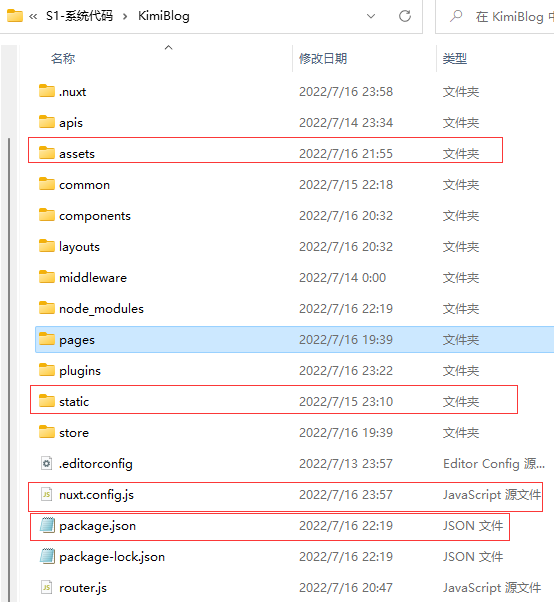
(3)使用pm2启动
pm2 start
6.2-Nuxt发布IIS绑定域名
参考文献:
1.安装ARR:https://www.likecs.com/show-527252.html?sc=504
2.Nuxt.js-IIS发布部署:https://blog.csdn.net/cplvfx/article/details/113940057
一、在IIS7中使用ARR(Application Request Routing)反向代理虚拟目录到Nodejs站点
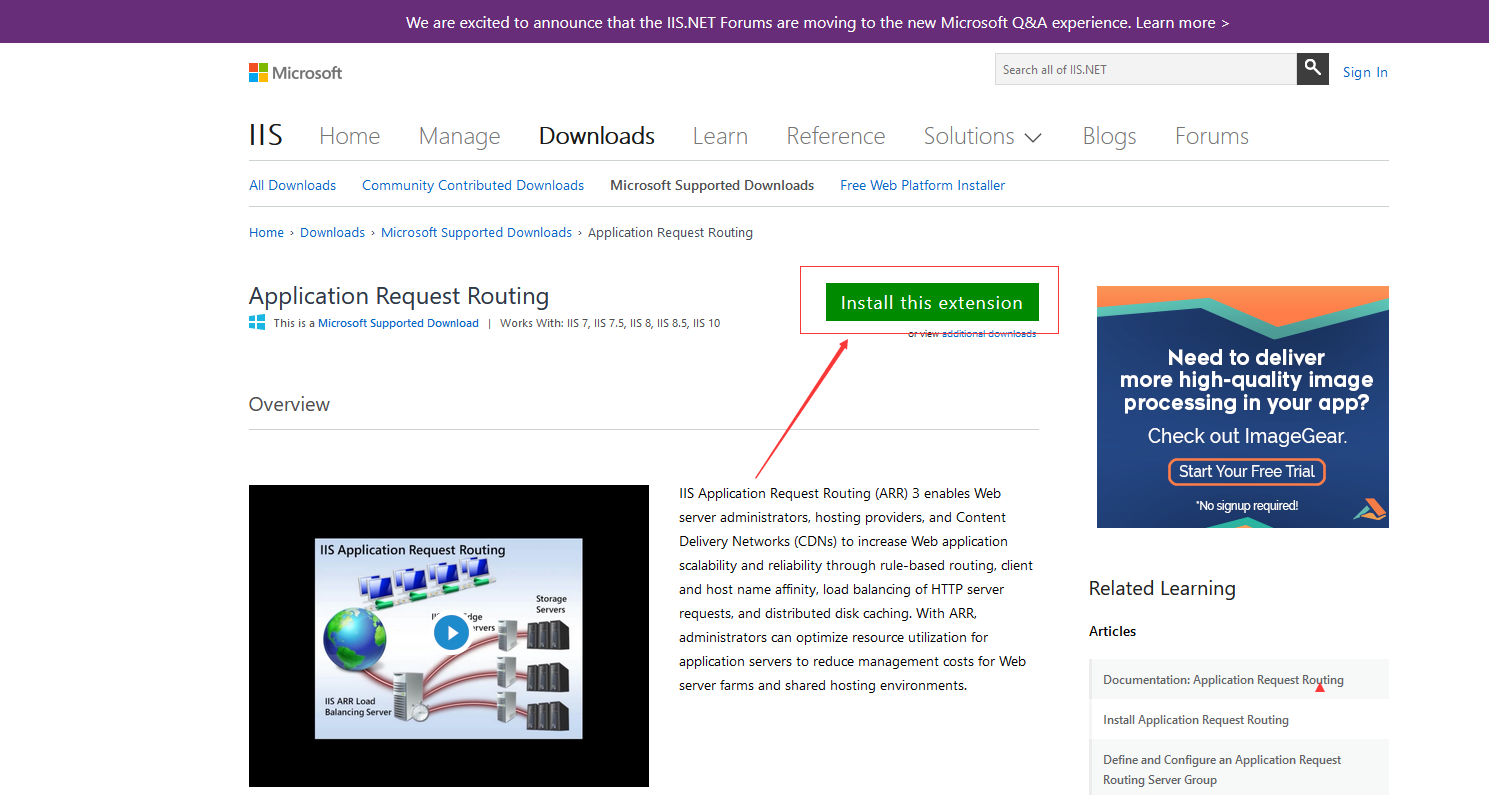

(2)将下载好的文件拷贝到服务器上,并双击安装(打开时间比较长,慢慢等就好了)。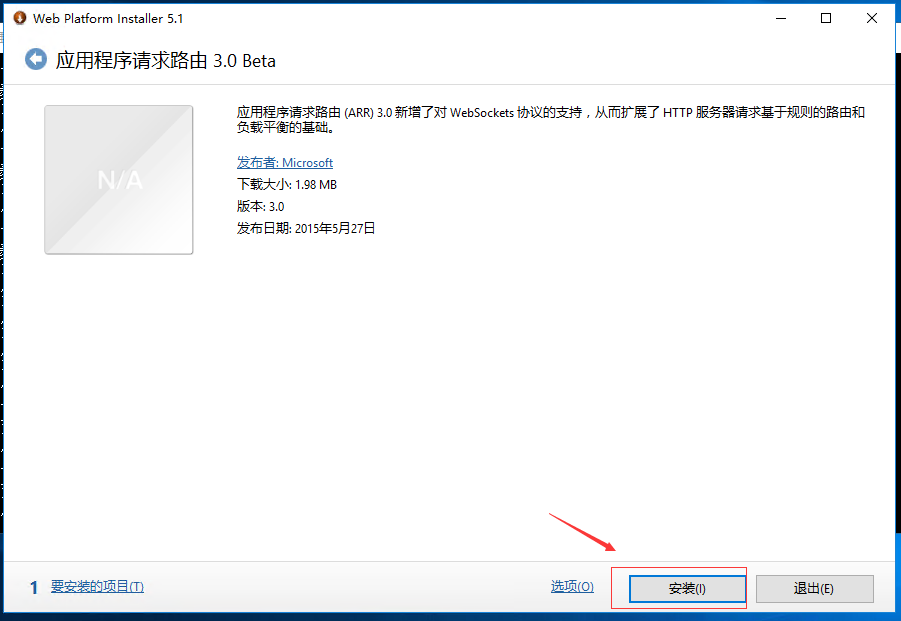
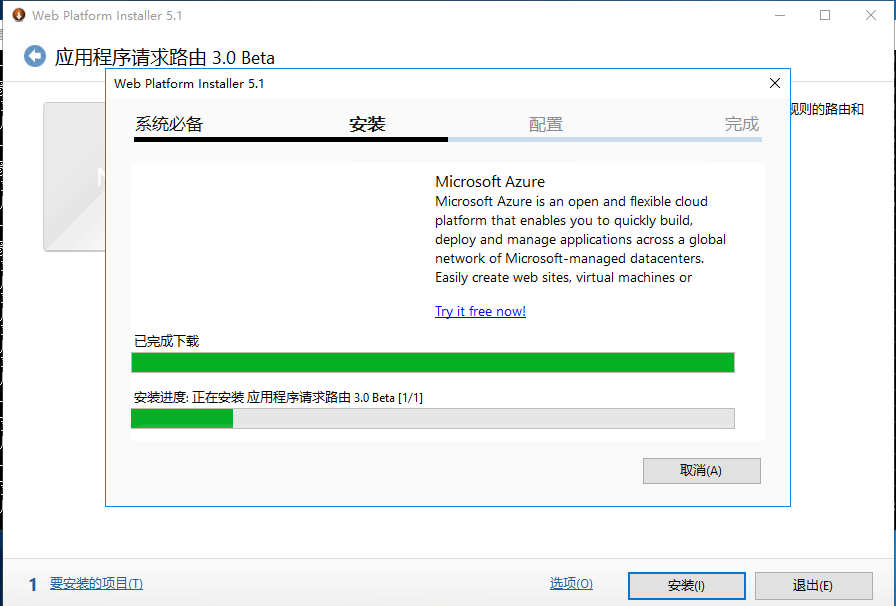
(3)安装成功后,重新打开IIS,出现这个图标说明安装成功了。
(4)双击【 Application Request Routing Cache 】图标,然后点击【Server Proxy Settings】。
(5)勾选【Enable Setting】,然后点击【应用】。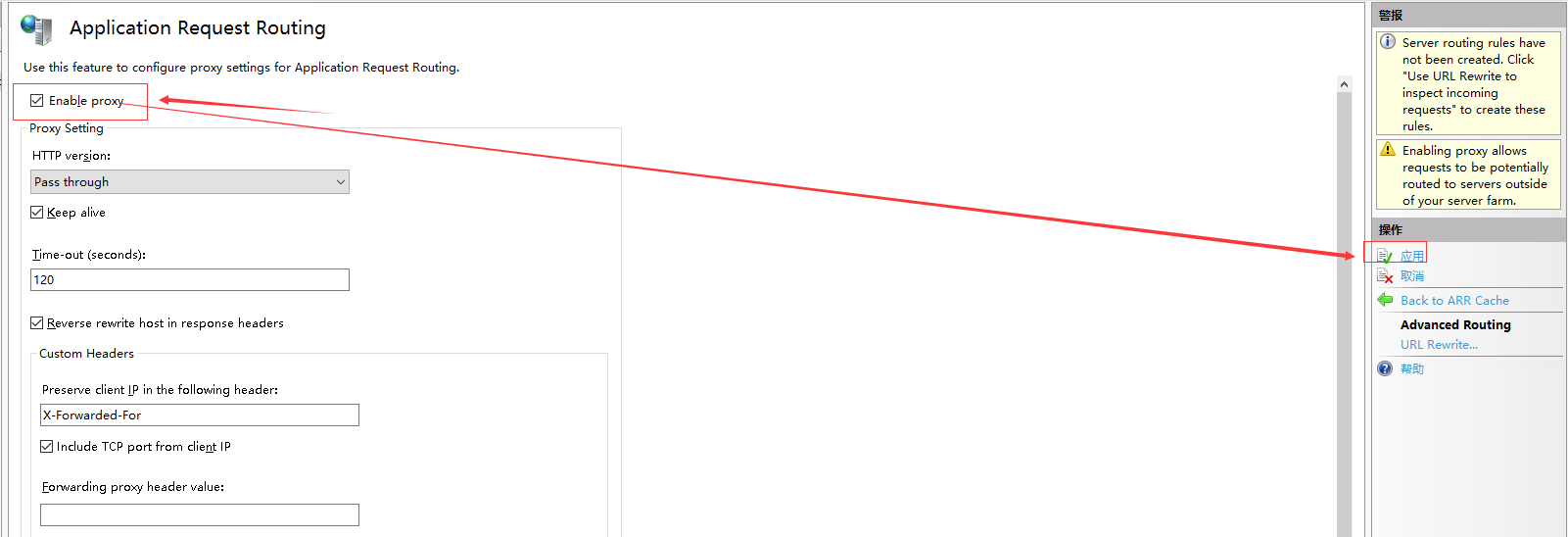
二、添加站点
(1)右击【网站】,点击【添加网站】。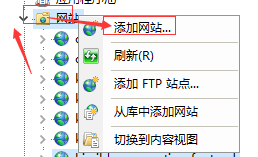
(2)填写基本信息。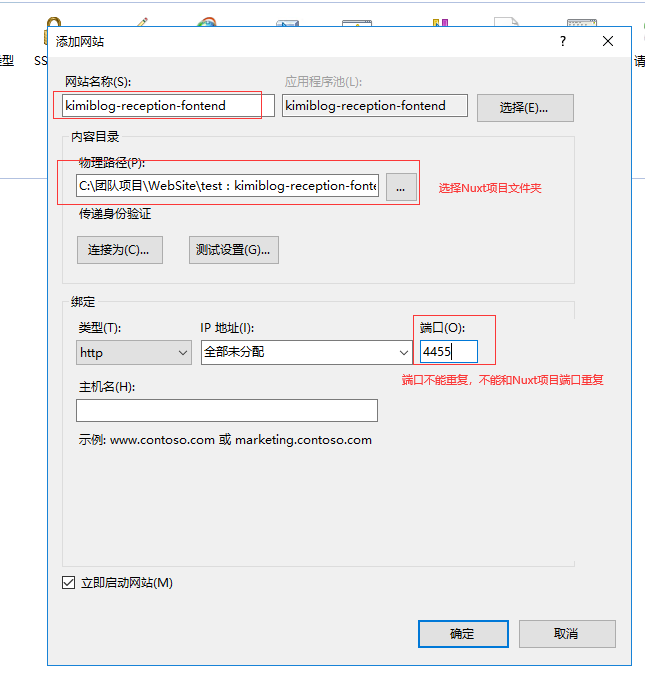
(3)然后点击刚刚创建的项目,再双击【URL 重写】,点击【添加规则】。

选择【反向代理】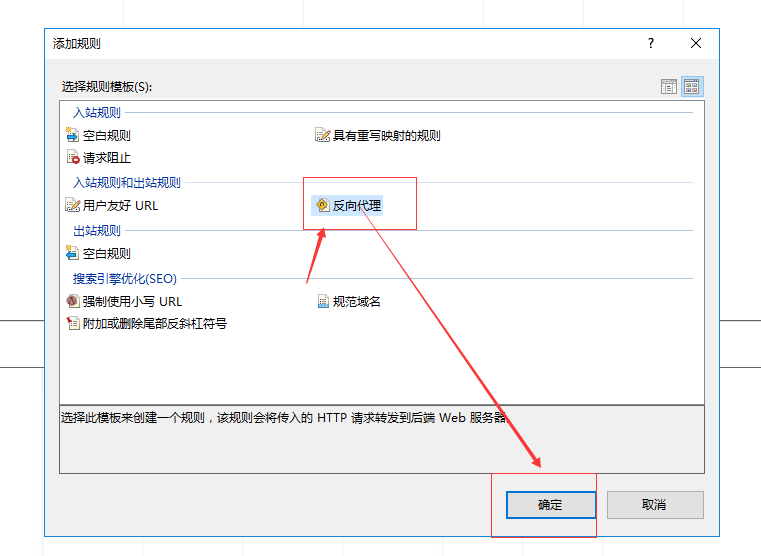
填写你原本用Node发布的Nuxt项目IP+端口即可,然后点击确定。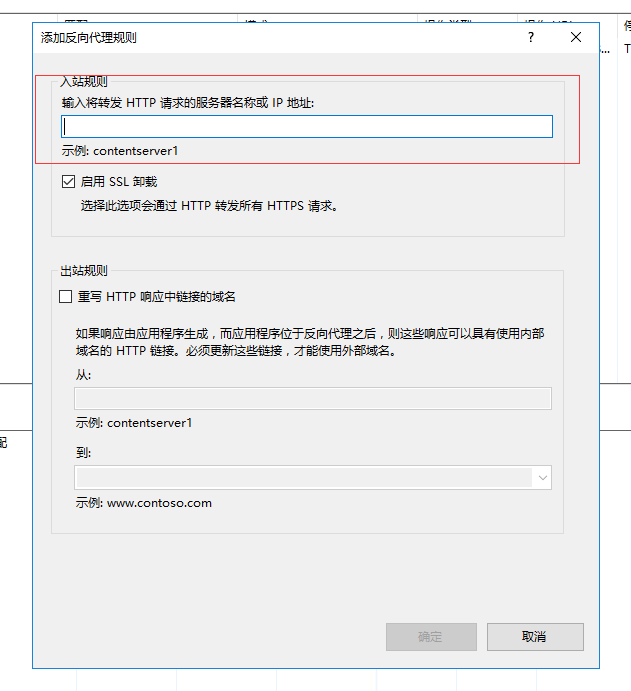
七、其他相关知识点
7.1-nuxt中使用cross-env配置环境变量
(1)使用命令安装依赖
npm i cross-env
(2)新建一个【env.js】文件,填写相关不同环境的配置信息。
export default { // 开发环境 dev: { NODE_ENV : 'development', // Base URL BASE_URL: 'http://xx.xx.xx.xxx:8081', // Base API VUE_APP_BASE_API: 'http://xx.xx.xx.xxx:8081' }, // 测试环境 test: { NODE_ENV : 'test', // Base URL BASE_URL: 'http://xx.xx.xx.xxx:8081', // Base API VUE_APP_BASE_API: 'http://xx.xx.xx.xxx:8081' }, // 生产环境 prod: { NODE_ENV : 'production', // Base URL BASE_URL: 'http://xx.xx.xx.xxx:8081', // Base API VUE_APP_BASE_API: 'http://xx.xx.xx.xxx:8081' } } (3)在【package.json】中配置。
"dev": "npm run dev:dev", "build": "npm run build:dev", "start": "npm run start:dev", "dev:dev": "cross-env MODE=dev nuxt", "build:dev": "cross-env MODE=dev nuxt build", "start:dev": "cross-env MODE=dev nuxt start", "dev:test": "cross-env MODE=test nuxt", "build:test": "cross-env MODE=test nuxt build", "start:test": "cross-env MODE=test nuxt start", "dev:prop": "cross-env MODE=prod nuxt", "build:prop": "cross-env MODE=prod nuxt build", "start:prop": "cross-env MODE=prod nuxt start", (4)在【nuxt.config.js】中配置。
import env from './config/env'; // 配置环境变量 env: { MODE: process.env.MODE }, // 代理 proxy:{ "/api":{ target:"http://xx.xx.xx.xxx:8081",//配置接口地址 target:env[process.env.MODE].VUE_APP_BASE_API,//配置接口地址 changeOrigin: true } }, 7.2-nuxt中使用svg-icon
(1)安装相关依赖
npm i svg-sprite-loader -D
npm i nuxt-svg-sprite-loader
(2)新建如下相关文件
【icon】放置svg文件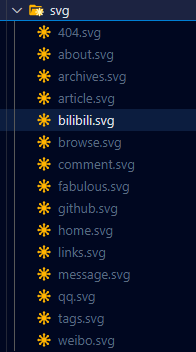
【index.js】
import Vue from 'vue'; import SvgIcon from '@/components/common/svg-icon'; // 导入SVG组件 // 全局注册 Vue.component('svg-icon', SvgIcon); // 三个参数:引入资源的目录 是否需要便利子目录 匹配文件的规则 const req = require.context('./svg', false, /.svg$/); const requireAll = requireContext => requireContext.keys().map(requireContext); requireAll(req); (3)在【nuxt.config.js】中进行配置。
plugins: [ '@/assets/icons' ], modules: [ ['nuxt-svg-sprite-loader', { symbolId: 'icon-[name]' }] ], 7.3-nuxt中使用cookie
(1)安装依赖
npm i --save cookie-universal-nuxt
(2)在【nuxt.config.js】中进行配置。
modules: [ 'cookie-universal-nuxt' ], (3)使用
const cookieValObject = { param1: 'value1', param2: 'value2' } // nuxt middleware——中间件 export default ({ app }) => { app.$cookies.set('cookie-name', 'cookie-value', { path: '/', maxAge: 60 * 60 * 24 * 7 }) app.$cookies.set('cookie-name', cookieValObject, { path: '/', maxAge: 60 * 60 * 24 * 7 }) } // client——客户端 this.$cookies.set('cookie-name', 'cookie-value', { path: '/', maxAge: 60 * 60 * 24 * 7 }) this.$cookies.set('cookie-name', cookieValObject, { path: '/', maxAge: 60 * 60 * 24 * 7 }) 7.4-nuxt中使用代码高亮highlight.js插件
参考文献:
(1)https://blog.csdn.net/qq2754289818/article/details/126396101
(2)https://blog.csdn.net/weixin_41897680/article/details/124925222
(1)安装
npm install highlight.js
(2)在【plugins】文件下添加一个【highlight.js】文件。
import Vue from 'vue'; import hljs from 'highlight.js'; // 样式文件(我选的是atom-one-dark-reasonable样式 可以通过highlight.js/styles 选择其他css) import 'highlight.js/styles/atom-one-dark-reasonable.css'; // 挂载highlight Vue.directive('highlight', function (el) { let element = el.querySelectorAll('pre'); element.forEach((block) => { hljs.highlightBlock(block); }); }); (3)在【nuxt.config.js】中引入。
plugins: [ '@/plugins/highlight' ], (4)在代码中使用
<div v-html='BlogArticleDetail.articleContent' v-highlight></div> 7.5-nuxt中使用全局水印
参考文献:
(1)实现水印:https://www.h5w3.com/239642.html
(2)nuxt自定义全局方法:https://blog.csdn.net/xuelang532777032/article/details/78414187
(1) 在【plugins】文件夹里新增一个【watermark.js】文件(文件名可以自己取)。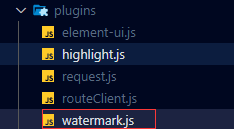
import Vue from 'vue'; let watermarkObj = {}; /** * 设置全局水印 * @text == 水印内容 * @sourceBody == 水印添加在哪里,不传就是body * */ let idGlocal = 'watermark_id'; let setWatermarkGlocal = (text, sourceBody) => { if (document.getElementById(idGlocal) !== null) { document.body.removeChild(document.getElementById(idGlocal)); } let can = document.createElement('canvas'); can.width = 500; can.height = 200; let cans = can.getContext('2d'); cans.rotate((-20 * Math.PI) / 180); cans.font = '15px Vedana'; cans.fillStyle = 'rgba(0, 0, 0, 0.05)'; cans.textAlign = 'left'; cans.textBaseline = 'Middle'; cans.fillText(text, can.width / 20, can.height); let water_div = document.createElement('div'); water_div.id = idGlocal; water_div.style.pointerEvents = 'none'; water_div.style.background = 'url(' + can.toDataURL('image/png') + ') left top repeat'; if (sourceBody) { water_div.style.width = '100%'; water_div.style.height = '100%'; sourceBody.appendChild(water_div); } else { water_div.style.top = '3px'; water_div.style.left = '0px'; water_div.style.position = 'fixed'; water_div.style.zIndex = '100000'; water_div.style.width = document.documentElement.clientWidth + 'px'; water_div.style.height = document.documentElement.clientHeight + 'px'; document.body.appendChild(water_div); } }; /** * 添加全局水印 * @text == 水印内容 * @sourceBody == 水印添加在哪里,不传就是body * */ watermarkObj.setGlocal = (text, sourceBody) => { setWatermarkGlocal(text, sourceBody); window.onresize = () => { setWatermarkGlocal(text, sourceBody); }; }; /** * 删除全局水印 * */ watermarkObj.removeGlocal = () => { if (document.getElementById(idGlocal) !== null) { document.body.removeChild(document.getElementById(idGlocal)); } }; // 设置全局方法 var watermark = { install(Vue) { Vue.prototype.$watermark = { // 设置全局水印 setGlocal: function (test, sourceBody) { watermarkObj.setGlocal(test, sourceBody); }, // 删除全局水印 removeGlocal: function () { watermarkObj.removeGlocal(); }, }; }, }; Vue.use(watermark); (2)在【nuxt.config.js】中进行配置。
plugins: [ { src: '@/plugins/watermark', ssr: false } ], (3)在xx.vue文件中使用。
【全局使用】
mounted() { // 添加水印 this.$watermark.setGlocal('©滔滔程序猿'); }, beforeDestroy() { // 删除水印 this.$watermark.removeGlocal(); }, 【局部使用】(注意:局部使用记得外外层div设置宽高)
<template> <div ref="content" style="width: 500px;height: 500px;border: 1px solid #ccc;"> </template> <script> export default { mounted() { // 添加水印 this.$watermark.setGlocal('©滔滔程序猿',this.$refs.content); }, beforeDestroy() { // 删除水印 this.$watermark.removeGlocal(); }, } </script> 7.6-nuxt中实现图片放大预览功能
(1)安装
npm install v-viewer
(2)在【plugins】文件夹里新增一个【viewer.js】文件(文件名可以自己取)。
import Vue from 'vue'; import Viewer from 'v-viewer' import 'viewerjs/dist/viewer.css' Vue.use(Viewer); Viewer.setDefaults({ Options: { 'inline': true, 'button': true, 'navbar': true, 'title': true, 'toolbar': true, 'tooltip': true, 'movable': true, 'zoomable': true, 'rotatable': true, 'scalable': true, 'transition': true, 'fullscreen': true, 'keyboard': true, 'url': 'data-source' } }); (3)在【nuxt.config.js】中进行配置。
plugins: [ { src: '@/plugins/viewer', ssr: false } ], (4)在xx.vue文件中使用。
<div class="markdown-body-box" v-viewer> <!-- 页面内容、图片等等 --> </div> 效果: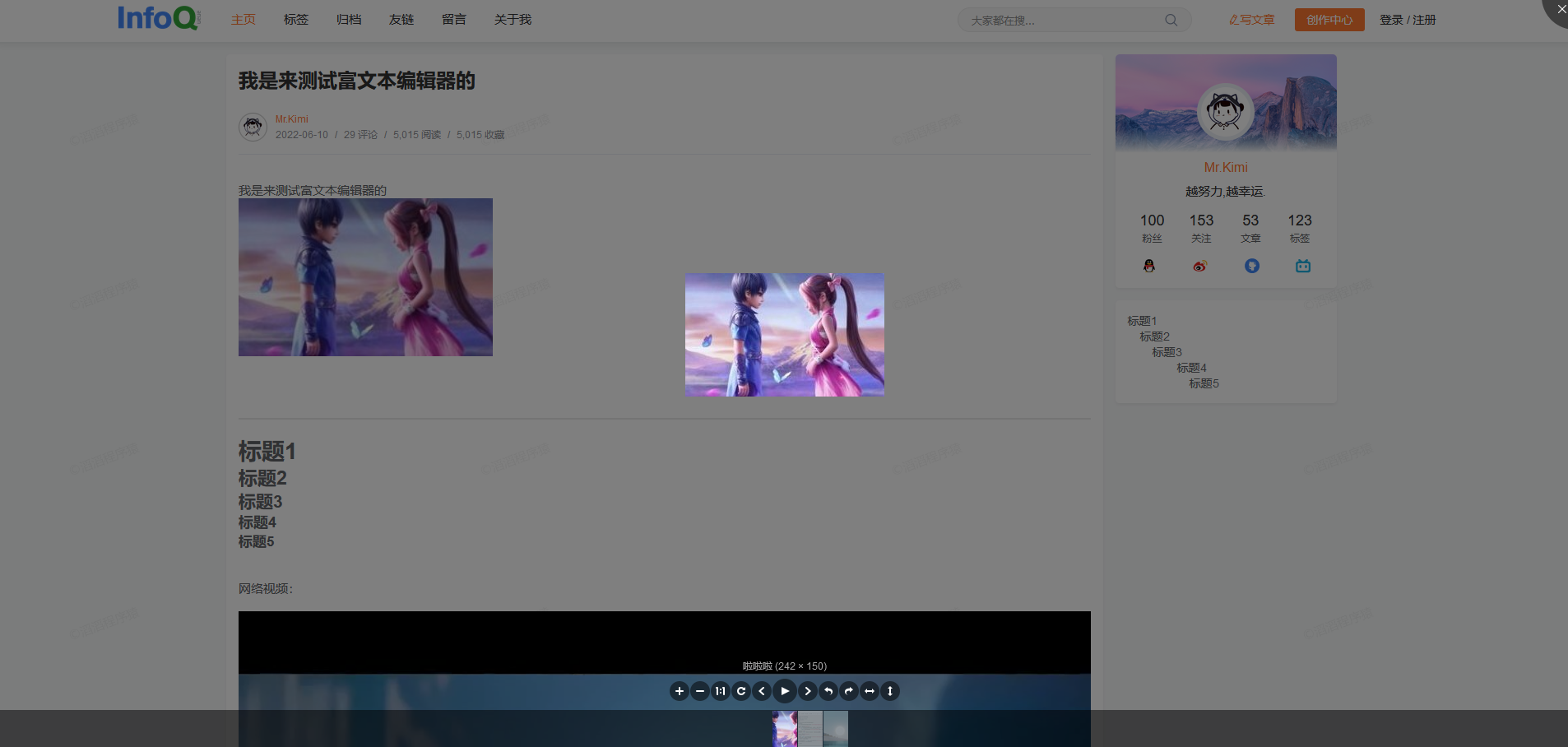
7.7-nuxt中使用windiCSS
(1)安装
npm i nuxt-windicss -D
(2)在【nuxt.config.js】文件中配置
buildModules: [ 'nuxt-windicss' ], (3)如果使用了TS可以进行配置。
"types": [ "nuxt-windicss" ] 
